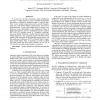Free Online Productivity Tools
i2Speak
i2Symbol
i2OCR
iTex2Img
iWeb2Print
iWeb2Shot
i2Type
iPdf2Split
iPdf2Merge
i2Bopomofo
i2Arabic
i2Style
i2Image
i2PDF
iLatex2Rtf
Sci2ools
ICASSP
2009
IEEE
2009
IEEE
Modeling instantaneous intonation for speaker identification using the fundamental frequency variation spectrum
In recent years, the field of automatic speaker identification has begun to exploit high-level sources of speaker-discriminative information, in addition to traditional models of spectral shape. These sources include pronunciation models, prosodic dynamics, pitch, pause, and duration features, phone streams, and conversational interaction. As part of this broader thrust, we explore a new frame-level vector representation of the instantaneous change in fundamental frequency, known as fundamental frequency variation (FFV). The FFV spectrum consists of 7 continuous coefficients, and can be directly modeled in a standard Gaussian mixture model (GMM) framework. Our experiments indicate that FFV features contain useful information for discriminating among speakers, and that model-space combination of FFV and cepstral features outperforms cepstral features alone. In particular, our results on 16kHz Wall Street Journal data show relative reductions in error rate of 54% and 40% for female a...
| Added | 21 May 2010 |
| Updated | 21 May 2010 |
| Type | Conference |
| Year | 2009 |
| Where | ICASSP |
| Authors | Kornel Laskowski, Qin Jin |
Comments (0)

